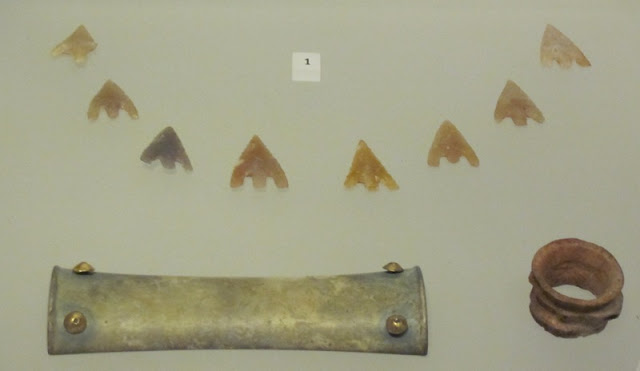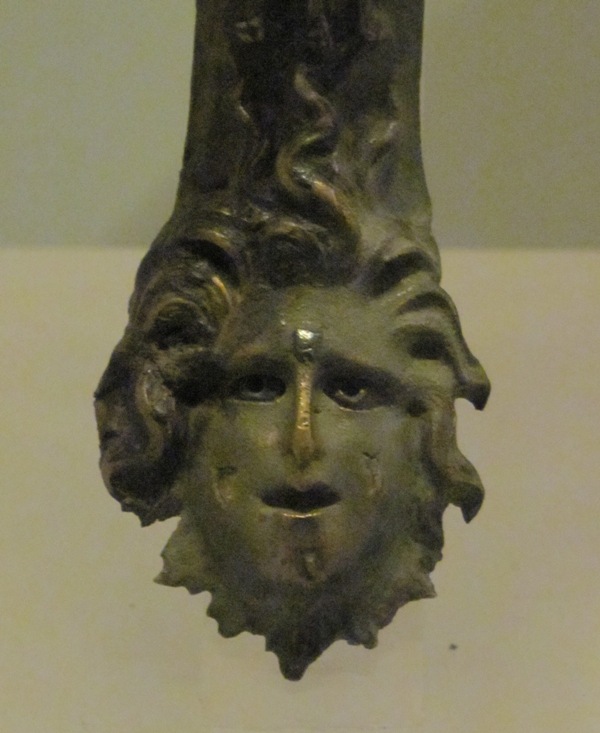Down in the basement of the National Museum of Scotland is a whole load of old stuff. So much so that we took two visits there to see it all properly. The exhibits down there are for the best part from the first millennium or before.
The first picture here shows some cup and ring markings, those mysterious carvings from deep in Scotland's prehistory (and other parts of Europe too). Those of you who have been with me for a while might recognise these as things I've posted about before, for others you can see some I visited "in the wild" about a year ago here
These arrowheads, wrist guard and buckle ring were all found in a grave at Culduthel in Inverness along with a decorated ceramic pot and a few other odds and ends. The date from somewhere between 2300 BC and 1800 BC. The wrist guard is made of stone but has metal rivets.
These two bronze blades date from 2200 BC to 1900 BC. By making a reproduction of what the knife would have looked like new, the museum have given us a far better idea of its original appearance.
Three axeheads from 3600 BC to 3000 BC
The period covered most extensively in the basement gallery is the Roman period - they were in Britain from 43 AD (although Julius Caesar popped over for a wee look in 55 BC) till about 410 AD. They did of course spend considerably less time in Scotland, finding us just a little...well...savage. I should point out, for the sake of international tourism, that it was a very long time ago and we're much nicer now. There are still plenty of signs of the Romans in Scotland and many artifacts have been found. I great number of those in the museum have come from the Newstead Roman fort near Melrose including this ornate bronze helmet.
Too fancy for your average legionary who would have had to make do with something along these lines, made out of iron.
They seemed to like their decorated jug handles.
Also in the collection are everyday objects from the period - here are some oil lamps, a couple of which still show some signs of having been used.
Some very mighty nails.
This isn't the greatest picture as the camera decided it wanted focus on something else. But if you look at the tile underneath you can see a dog has run over the tile while it was wet. Probably produced a bit of Latin bad language from a Roman Potter.
A rather fancy spoon.
This one really caught my fancy. Who'd have thought that somebody made a folding spoon nearly 2000 years ago.
Some colourful bits of Roman bangles
A set of coins from the reign of the Emperor Trajan 98 - 117 AD. They are from left to right in descending value,an aureus, denarius, sestertius, dupondius, as, semis, and a quadrans.
This is the remains of a carnyx found in Deskford in Moray. The carnyx is a type of iron age war trumpet that the Romans would have had to face on many of their campaigns - not just in Scotland. The Greek historian Diodorus Siculus wrote of them, "Their trumpets again are of a peculiar barbarian kind; they blow into them and produce a harsh sound which suits the tumult of war"
Based on pictures from the time and other carnyxs from elsewhere this reproduction has been made.
A little later in history, this set of scales and weights dates from around 875 to 925 AD and was found in a viking grave at Kiloran Bay on the Island of Colonsay in the Inner Hebrides.

The next three pictures are all of part of the St Ninian's Isle Treasure found in 1958. They are all thought to be Pictish in origin, dating from about 800 AD and probably belonged to the church on the island who at some point have buried them for safe keeping (though perhaps not meaning to keep them safe until quite 1954). All the pieces shown here are silver gilt.
A brooch
Three objects described on the museums page as conical, in other places as mounts, and generally I don't think they really know.
The chape (the bit at the bottom) of a sword scabbard.
And almost up to date, on the way into the museum basement are these sculptures by Sir Eduardo Paolozzi (Edinburgh sculptor who lived from 1924 to 2005). They have little cabinets within them - not great for displaying things but good to look at on the whole.



























6 comments:
Interesting stuff you found in the basement. Loved the comment about the savagery of the Scots.
Wow, you got to see some very interesting things there. Isn't history great?
I really like your commentary too and I have to agree with you - us Scots are very friendly people now.
Thanks for visiting and commenting I loved your comment 'hirsute herbage' that really made me laugh. Great sense of humour.
Some great history there, and I learned a new word - never heard of a chape before. Thanks for that.
Fascinating post Sandy.
I particularly like the Carnyx, being a musician, do you think you could get a tune out of it ?
Shamefully I haven't visited it yet. And I work nearby...
Thanks John - We certain did seem quite a dangerous crowd on those days.
Thanks Ellie - your right - we are perfectly friendly now. Mind you if the Italian tried to annex us like they did 2000 years ago we might still be a dangerous people.
Shundo - my vocabulary is no greater than yours - I had to look it up too, thus the brief explaination.
Jim - a big bit about playing music is brass neck and the carnyx comes with plenty off that.
On the rare occasions I've tried an instrument that require blowing, I've found myself pretty puggled fairly quickly.
Linda - the museum is large and much of it newly opened (as well you'll know) so no shame in not having seen it all yet. I'm not sure how long the bit downstairs has been open. I remember some of the basement stuff from years ago (a great diorama of the ancient forest with wolves and a boar which isn't in my blog) but the stuff here is all new to me so it might not have been open long.
Post a Comment